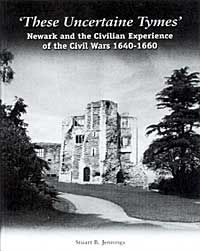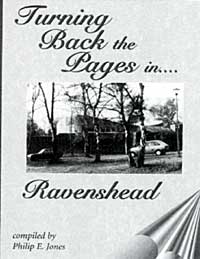Book reviews, Winter 2009
Stuart B. Jennings, 'These Uncertain Tymes'; Newark and the Civilian Experience of the Civil Wars 1640-1660. Nottinghamshire County Council, 2009. ISBN: 978-0-902751-62-0

Stuart Jennings is a well-known researcher and writer of local history, and his previous studies of the Newark-based regiment of Colonel William Staunton have made an ideal foundation for this informative and enjoyable 146 page book.
'These Uncertaine Tymes' is an apt title for his detailed account of the impact of the Civil Wars on Newark and its citizens subsequent struggle for survival. The author starts by placing the town in context. At the beginning of the seventeenth century, Newark was the second largest town in Nottinghamshire, an ancient and thriving market town distinguished by somewhat dilapidated medieval walls and gates. By the 1630s Newark town was suffering economic difficulties resulting from reductions in trade along the river Trent. Poor harvests and falling trade in grain added further to its hardship, and as Newark approached the 1640s it was clearly a town ill-prepared, both economically and defensively, for the coming conflict. Despite its problems, Newark's riverside location meant that it was strategically important to the Royalists as a centre for communication. By controlling Newark, they would safeguard vital routes to King Charles' headquarters at Oxford and the important towns of York and Newcastle.
A superb narrative captures the tensions within the town during the descent into civil war and during the subsequent sieges, as Parliamentarian Nottingham sought to break the Royalist's grip on Newark. As the opposing sides prepare for conflict, soldiers and townspeople alike are seen to be working together to fortify their town. Within ten weeks the ramparts had been strengthened and ditches dug around strategically important locations. The author uses fascinating contemporary eyewitness accounts in bringing the conflict to life as it develops. There are vivid descriptions of an early skirmish, which tests the town's defences of artillery bombardment and Parliamentary cavalry charges viewed from the top of St. Mary Magdalene's spire. The ebb and flow of Royalist and Parliamentary fortunes culminated in the third and final siege, ending in the surrender of Newark in May 1646. Events during and after the sieges, and their impact on the lives of the ordinary inhabitants of Newark are skilfully described and analysed, and the use of contemporary descriptions provides a series of snapshots of life for both soldiers and citizens. Due to the ruinous state of the castle, the task of billeting soldiers fell to ordinary citizens in Newark and the surrounding villages. Costs are itemized for the cleaning and repair of stables and the removal of filth from surrounding streets. A fascinating account is given of how ingredients were obtained for the manufacture of gunpowder. The quality of food deteriorated during the winter of 1645-6 causing conflict between town and garrison, but not as severe, perhaps, as a surviving example of Parliamentarian propaganda suggests.
A grim picture of the town emerges, with typhus, an occupational hazard for soldiers serving in seventeenth century armies, quickly spreading through the population during 1643 to 1645. According to a contemporary account, Royalist soldiers brought plague into the town in 1646, which may have helped avoid immediate occupation of the town following surrender. Interesting references from primary sources include public orders recorded in the Borough minute book detailing instructions on how to control the plague. Snapshots of individual family tragedies reveal an example of a father and four children dying within 21 days of infection. The author states that both diseases killed more of Newark's civilians than the fighting.
Despite the effects of the Civil War, documentation indicates leaders and civilians of Newark were determined to maintain a semblance of normality, including the provision of poor relief and education. An analysis of marriages between 1630 and 1659 reveals, surprisingly, an increase over the period 1644-1646 as the uncertainty of the war encouraged couples into wedlock. An equally detailed analysis of the baptismal registers of the parish church provides an insight into contemporary childbirth statistics, with an increase in births shown for the years 1643-45. The author's opinion is that, despite difficult times, 'couples continued to fall in love and create new families'.
Following the execution of Charles 1 in January 1649, England, Wales and Ireland were declared to be a 'commonwealth and free state'. The author reveals that it was not until 1650 that the new republican authorities focussed their attentions on former Royalist Newark. Royalist aldermen were removed from the Corporation, an act that almost caused complete chaos, and there is a wonderfully detailed account of how the town corporation remained largely in the hands of wily Royalist supporters.
The medieval church of St. Mary Magdalene did not escape unscathed, and the events of the 1640s and 1650s are covered in the churchwardens' accounts for this period. It is suggested that lead from the roof may have been used to manufacture musket balls for the Royalist garrison; medieval glass was deliberately destroyed by Puritan iconoclasts, and several other furnishings, including the organ and pulpit were removed before they too became victims of the new regime. Fasts, sermons and enforcement of Sabbath observance describe the new regime's impact and the abolishing of Christmas celebrations is revealed.
The book has a pleasing layout with well-spaced text. Its narrative is well supported by a contents page and index, and with photographs, maps and tables. There is a useful chronology of the first Civil War relating to Newark along with extensive end-notes and bibliography for those who wish to read more about this fascinating subject. This book deserves to be widely read by local historians and anyone with an interest in this period and Newark's history.
Colin Pendleton
Philip E. Jones, Turning Back the Pages in Ravenshead, 2009, Nottinghamshire County Council ISBN: 978-0-9027151-64-4

Recently published by Nottinghamshire County Council is this collection of Ravenshead images compiled by lifetime resident of the village, and well- known Thoroton Council member, Philip Jones. The book has 40 pages, 38 of which carry images, all in black and white but reproduced to a high quality. Each image is captioned by Philip in a most informative way and the book provides a record of the history of Ravenshead which is of wider interest than just to residents, current and past.
As would be expected there are several pictures of what the countryside looked like before the 1960s and later housing developments took place and which show the reader what was lost in these developments. Ravenshead is, of course, not alone in losing parts of the countryside to such development and we are seeing today the prospective loss of large tracts of greenbelt land to similar developments as, for example, at Sharphill in Rushcliffe. Philip's book is a reminder to record such land before it is subsumed in concrete. Of particular interest in the book are the pictures of buildings no longer extant; the ex-Army hut bought in 1946 and erected as St. Peter's Church Hall used until 1971; the Free Methodist chapel built in 1864 which was reputed to be the smallest chapel in the county at 25x27 feet and gave Chapel Lane its name; Newstead hospital opened in 1942 by the City of Nottingham as a TB sanatorium and the old Post Office which closed in 2000. There are several other such representations of much interest.
The book costs £3.95 from the Thoroton bookstall and libraries in Nottinghamshire. It can also be bought direct from the author at £4.50 including p&p, contact Philip at 40, Regina Crescent, Ravenshead, Nottingham, NG15 9AE.
Howard Fisher.
Mark Dawson, Plenti and Grase:food and drink in a sixteenth-century household, 2009, Prospect Books. ISBN: 978 1 903018-56-9. £30.00
Dr Mark Dawson gave the Thoroton Society's Nottinghamshire History Lecture in 2008 on the subject of food (Transactions 112, 2008, pp. 159-76) and he has now published a study of eating and drinking at Wollaton Hall. Mark spent many hours working through the Willoughby family papers, which are housed in the University of Nottingham's Manuscript Department, and has as a result been able to answer all sorts of questions about what they consumed in an aristocratic household. The book has two main sections, one dealing with supply and the other with demand. Supply is about where the Willoughbys bought their food, whether locally or from London, and from markets, fairs and other suppliers. It is about what they ate, including bread, meat and dairy products, fish, fruit and vegetables, salt, vinegar, honey, wine, sugar, spices and dried fruit. The second main section looks at how the food arriving at Wollaton was processed for the table, and then how it was eaten. We learn about storage and preservation, about cooks and their kitchen, mealtimes, menus, dining arrangements, salted herrings, turkeys, food spicing, beer, and much more besides. This is the story of an aristocratic rather than a representative household - the book's title is not helpful, although if you worked below stairs at Wollaton you could eat pretty well. Mark Dawson provides a wealth of detail about the food of our ancestors, and in particular a new perspective on a house we all know and love. Finally, hands up: how many Thorotonians knew that 'the perfumed scent of rose-water was much prized in Tudor cookery' (p. 171)?
John Beckett
Ed: My wife was given a recipe for Christmas cake by her first husband's grand mother which included rose-water. It was slightly oily and added moisture to the cake. It could be bought at a shop in Darlington in the 1970s.